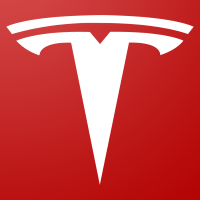
Tesla is a vertically integrated sustainable energy company that also aims to transition the world to electric mobility by making electric vehicles. The company sells solar panels and solar roofs for energy generation plus batteries for stationary storage for residential and commercial properties in... Tesla is a vertically integrated sustainable energy company that also aims to transition the world to electric mobility by making electric vehicles. The company sells solar panels and solar roofs for energy generation plus batteries for stationary storage for residential and commercial properties including utilities. Tesla has multiple vehicles in its fleet, which include luxury and midsize sedans and crossover SUVs. The company also plans to begin selling more affordable sedans and small SUVs, a light truck, a semi truck, and a sports car. Global deliveries in 2021 were a little over 936,000 units. 더 보기
| 기간 | 변동 | 변동 % | 시가 | 고가 | 저가 | 평균 일일 거래량 | VWAP | |
|---|---|---|---|---|---|---|---|---|
| 1 | -29.96 | -10.2898749828 | 291.16 | 303.94 | 261.06 | 110471110 | 282.06472515 | CS |
| 4 | -111.98 | -30.0069671472 | 373.18 | 380.4031 | 261.06 | 89414268 | 319.81036182 | CS |
| 12 | -163.64 | -38.5180303173 | 424.84 | 488.5399 | 261.06 | 85228463 | 381.95345466 | CS |
| 26 | 28.6 | 12.2957867584 | 232.6 | 488.5399 | 210.51 | 86504646 | 326.94916025 | CS |
| 52 | 81.2 | 45.1111111111 | 180 | 488.5399 | 138.8025 | 90270242 | 258.28925055 | CS |
| 156 | -24.10250657 | -8.44805286142 | 285.30250657 | 488.5399 | 101.8246 | 97142629 | 227.61586613 | CS |
| 260 | 215.04619837 | 465.93387928 | 46.15380163 | 488.5399 | 23.34396682 | 69552931 | 224.32030983 | CS |
 Genz2
1 시간 전
Genz2
1 시간 전
 Genz2
1 시간 전
Genz2
1 시간 전
 Genz2
2 시간 전
Genz2
2 시간 전
 Hoskuld
2 시간 전
Hoskuld
2 시간 전
 Hoskuld
2 시간 전
Hoskuld
2 시간 전
 Genz2
3 시간 전
Genz2
3 시간 전
 Matrix999
3 시간 전
Matrix999
3 시간 전
 Genz2
5 시간 전
Genz2
5 시간 전
 Prudent Capitalist
5 시간 전
Prudent Capitalist
5 시간 전
 Genz2
6 시간 전
Genz2
6 시간 전
 Matrix999
6 시간 전
Matrix999
6 시간 전
 Prudent Capitalist
7 시간 전
Prudent Capitalist
7 시간 전
 jimr1717
8 시간 전
jimr1717
8 시간 전
 STOCKMONSTER
9 시간 전
STOCKMONSTER
9 시간 전
 Genz2
10 시간 전
Genz2
10 시간 전
 Prudent Capitalist
10 시간 전
Prudent Capitalist
10 시간 전
 Genz2
11 시간 전
Genz2
11 시간 전
 jimr1717
11 시간 전
jimr1717
11 시간 전
 Genz2
11 시간 전
Genz2
11 시간 전
 GARYM1
12 시간 전
GARYM1
12 시간 전
 Hoskuld
12 시간 전
Hoskuld
12 시간 전
 GARYM1
13 시간 전
GARYM1
13 시간 전
 Genz2
1 일 전
Genz2
1 일 전
 Genz2
1 일 전
Genz2
1 일 전
 Hoskuld
1 일 전
Hoskuld
1 일 전
 Genz2
1 일 전
Genz2
1 일 전
 Genz2
1 일 전
Genz2
1 일 전
 georgejjl
1 일 전
georgejjl
1 일 전
 Genz2
1 일 전
Genz2
1 일 전
도움 및 지원받기: kr-support@advfn.com
ADVFN 서비스 이용은 ADVFN의 이용약관에 동의하는 것입니다 이용약관